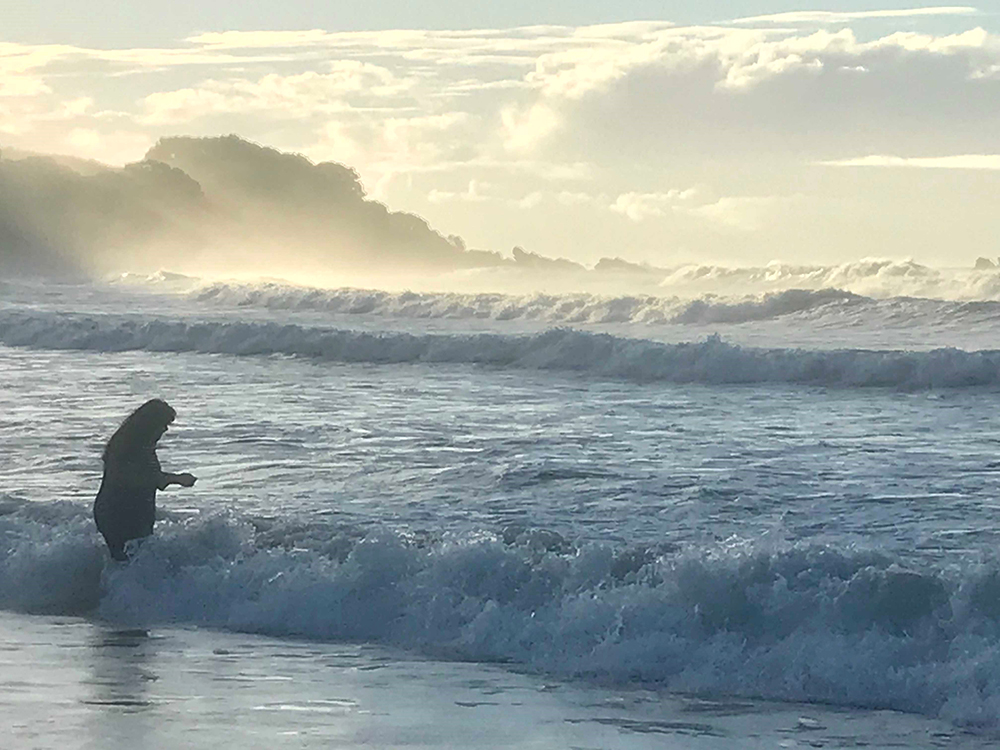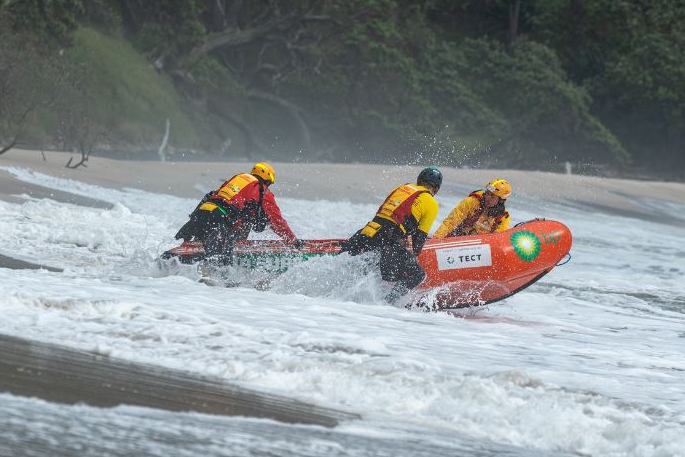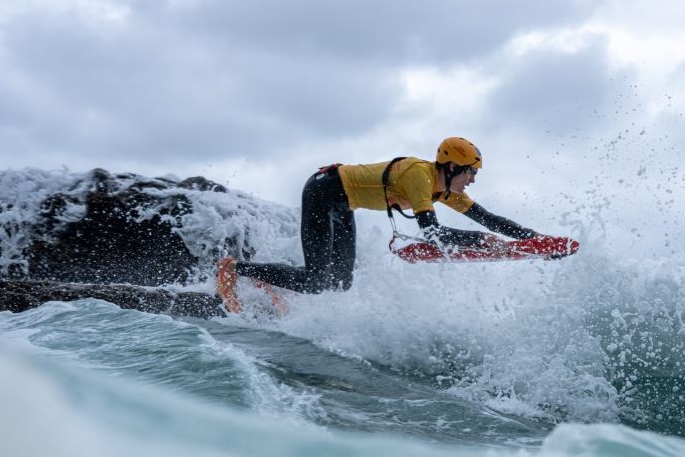Surf life guards are being called heroes following harrowing rescues on Wednesday.
Surf swells along Bay of Plenty coastal shores this week are unleashing drama causing water levels to surge and unsuspecting swimmers to be swept sideways into treacherous rip currents.
“It’s been busy,” says Surf Life Saving New Zealand's Eastern Region lifesaving manager, Chaz Gibbons-Campbell.
“We’ve had a number of issues at Omanu, Tay Street, Pāpāmoa and Whangamatā. With the tide and the surf coming in there’s a lot of water trying to get out. It’s taking people sideways out of the flag areas and into a rip current.”
With the intense swells and unpredictable shifts in water dynamics this week, beachgoers are urged to exercise caution and adhere to the surf lifeguard safety guidelines, namely swimming between the flags.
On Wednesday local surf life guards found themselves in a relentless battle against nature’s force, working tirelessly to rescue some distressed swimmers caught in the tumultuous waves and rips.
Pāpāmoa
At Pāpāmoa beachgoers watched as two youth were rescued by Pāpāmoa Surf Life Club lifeguards.
“They drifted out of the flags and clung to each other as they were being carried away in a strong rip,” says a beachgoer watching the scene unfold.
“I was between the flags with my two children and keeping an eye on them, and saw the lifeguard go to the water’s edge beckoning to two people being carried out of the flags. They were being drawn further away out into the sea.
“Their caregiver raced out into the water and it looked like she was the third person to be rescued. The life saver ran and got a board and brought all three of them in with another life saver who went and helped.
“I thought it was fantastic to see what was happening. They would have been goners without the surf lifeguards. They are heroes.”

Photo: Supplied.
Chaz says the rescue of the trio at Pāpāmoa was “only 50 metres or so into the water but they found that the feeder currents are sweeping them across the beach and they couldn’t get back in”.
“The two lifeguards went out on rescue boards and assisted the two boys and their caregiver back to shore. One life guard responded initially to the two boys and the other one went back to the caregiver.”
It was a busy morning at Pāpāmoa, with Hato Hone St John involved in an earlier rescue of an injured body boarder who is now in hospital.
“We were alerted at 10.41am,” says a Hato Hone St John spokesperson.
“A body boarder was taken to Tauranga Hospital with severe injuries, involving one ambulance.”
Chaz says the major first aid incident occurred at Motiti Reserve in Pāpāmoa East.
“We were alerted by St Johns so life guards headed down there. A male had been body boarding, came down a wave, hit his head on the sand, was in a lot of pain,” says Chaz.
“Lifeguards got there, immobilised him and got him to the ambulance where staff gave him pain relief. They had to transport him from Motiti Reserve down to Taylors Reserve in the beach buggy ATV to the waiting ambulance. “
 Surf Life Saving New Zealand's Eastern Region lifesaving manager, Chaz Gibbons-Campbell. Photo: Supplied.
Surf Life Saving New Zealand's Eastern Region lifesaving manager, Chaz Gibbons-Campbell. Photo: Supplied.
Pāpāmoa lifeguards also had a report of a bag theft, with the owners able to track it using an iPhone app.
“It was stolen down at Hartford Ave and the owners were able to track it back to the Pāpāmoa Surf Club area where the lifeguards were able to help and it was reported to police,” says Chaz.
“They said they got their phones back which was really good and were just missing some air pods.”
Mount Maunganui
Chaz says while the Pāpāmoa East body boarder rescue was happening, Mount Maunganui lifeguards were responding to a first aid up incident on Mauao where an elderly person had fallen over on gravel and had cuts and scratches on their legs.
“The lifeguards walked to that one, it was near markers 5 and 6 on the base track. Lifeguards gave them first aid and they walked out themselves.”
.jpg) Mount Maunganui surf. Photo: John Borren.
Mount Maunganui surf. Photo: John Borren.
Omanu and Tay Street
“A bit later on Omanu lifeguards did had a welfare check,” says Chaz. “They’d seen someone who was pulled across into the feeder current and shadowed them across to get back into shore.
“About 4pm Tay Street lifeguards spotted an elderly woman south of the flags struggling against a rip current. The lifeguards went out and performed a board rescue. It’s only 25 metres off shore which isn’t very far but we’re finding these currents are quite strong and people are struggling to get back in and losing their footing.”
Chaz says at around 1pm at low tide, there was a bit more water on the sand bank so people were losing their footing, with the outgoing tide producing a lot of “pull”.
“It’s not the really big surf where we get the rescues but between a metre and a metre and a half where people feel confident to go out but there’s still a lot of water moving around - in particular when the tide is going from high tide to a low tide.”
Tairua and Hot Water Beach
A mass rescue took place in front of the surf club at Tairua on Wednesday involving an Inflatable Rescue Boat - IRB.
“Three life guards responded to seven people,” says Chaz.
“Four kids who were quite far out had drifted past the flags. Their grandmother came and got a lifeguard. There were others out there too - an off-duty lifeguard and two adults trying to help them back to shore.
“The lifeguards on duty responded with a tube rescue which brought one person back in, while an IRB brought two back to shore and then went back to bring in another two back to shore. The others made their own way back in.”
There were also two assists at Hot Water Beach, where two boogie boarders who had drifted out in a rip and had an assist pushing them back to shore.
 Launching an IRB. Photo: Supplied.
Launching an IRB. Photo: Supplied.
Whangamatā
On Wednesday morning, surf lifeguards from Whangamatā Surf Life Saving Club were tasked to assist in the rescue of a person stuck on Whenuakura (Donut Island) in Whangamatā.
The person was last seen entering the island, which has a lagoon in the middle of it, at 9am by someone on a jetski. The surf was large, with big swells rolling in through the entrance of the island.
Three surf lifeguards responded with a Rescue Water Craft at 9.45am.
 Surf Life Saving NZ lifeguards. Photo: Kim Baker Wilson.
Surf Life Saving NZ lifeguards. Photo: Kim Baker Wilson.
Due to the rough conditions, an IRB with three surf lifeguards onboard was also launched at 10.15am to assist.
At 11.15am, the person was retrieved safely and returned to shore, where they were assessed.
While the rescue was being carried out, Whangamatā SLSC Search and Rescue Squad assisted with the patrol.
“Whenuakura is a popular spot for people to go. However, Surf Life Saving New Zealand would like to take this opportunity to remind people that you should always check the conditions before going in,” says a SLSNZ spokesperson.
“Too many people get into trouble in the water because they overestimate their abilities and underestimate the conditions.
“Also, if someone in the water is in trouble and surf lifeguards are on patrol, let them know. If you can’t see any surf lifeguards, call 111 and ask for Police.”
Coromandel v Bay of Plenty wave size
Chaz says the surf size in Coromandel is bigger than in the Bay of Plenty.
“It’s quite dumpy – we call it a plunging wave, that throws you around like a washing machine,” says Chaz.
“It’s about 1.5 metre in Tairua, compared to about 1 metre here in the Bay of Plenty.
“It’s meant to die off over the next few days into the weekend and then we will have another bump on the weekend.
“Make sure you are swimming between the red and yellow flags, be cautious of the feeder currents that can pull elderly and unsuspecting people off their feet.”
 Swim between the red and yellow flags. Photo: Supplied.
Swim between the red and yellow flags. Photo: Supplied.
Chaz says if you are needing assistance make sure you are raising your hand. The incidents on Wednesday were mitigated by lifeguards who were alert, attentively watching people in the water.
“In all these cases, lifeguards have recognised they could be in trouble and have responded.”



0 comments
Leave a Comment
You must be logged in to make a comment.